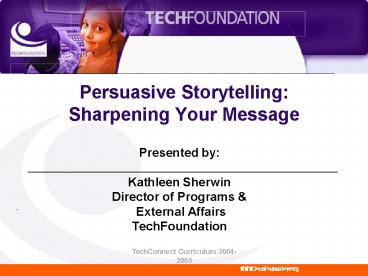Persuasive Storytelling: Sharpening Your Message - PowerPoint PPT Presentation
1 / 20
Title:
Persuasive Storytelling: Sharpening Your Message
Description:
Integrating storytelling methods or the narrative form to the grantseeking proposal process ... Characters: Protagonist and Antagonist. Setting: Time and Place ... – PowerPoint PPT presentation
Number of Views:60
Avg rating:3.0/5.0
Title: Persuasive Storytelling: Sharpening Your Message
1
Persuasive Storytelling Sharpening Your Message
- Presented by
- Kathleen Sherwin
- Director of Programs
- External Affairs
- TechFoundation
.
2
Goals Objectives
- What makes a good Story Learn the elements of
a good story (narrative proposal) - Who will listen to my Story Discover how to
find and cultivate your target audience - Why listen to my Story Understand the tools
needed to package and market your story
3
What is Storytelling?
- Integrating storytelling methods or the narrative
form to the grantseeking proposal process - Effective way to communicate need, offer
solutions and opportunity to participate
4
Your Turn What makes a Compelling Story?
- At the bookstore-how did you make your selection?
- What ads (print or media) are most memorable?
5
What are the Elements?
- Proposal Narrative should include
- Characters Protagonist and Antagonist
- Setting Time and Place
- Plotline Introduction, Conflict, Building of
Tension, Climax and Conclusion
6
Ready to Start Questions to Ask
- Is your story ready to be told?
- Is your project/story fundable?
- Why are you seeking the grant?
- Have you spent time in the field?
- Have you spent time with the staff and clients to
gain ideas, data and insight?
7
Who is the Target Audience?
- Research the Potential Grantor Does your story
fit their preferences of geography, sector, size
of grant and type of grant? - Research Using Alternative Resources Research
using the internet, publications, media, print,
nonprofit co-workers and professional network - Keep Track of Your Potential Grantors Develop
grant calendar to stay on track and continue to
update your research
8
Developing Relationships with your Target
Audience
- Letter of Inquiry or Letter of Intent
- Communication during the Grant Process
- Site Visits
- Personal Connections
- Accepted
- Rejected
9
Storytelling Element 1 Introduction The
Hook/Summary
- Provide an initial hook
- Present the essential and basic information about
your organization - Introduce the Hero and Main Characters
- Establish Sense of Time and Place
- Establish Credibility
10
Storytelling Element 2 Conflict/Social Need or
ProblemWelcome the Antagonist
- Define the Need or Social Problem
- Define the Antagonist What is the negative
impact? - Use data and statistical information
- Humanize your story Incorporate quotes, photos
etc. - Focus on your characters needs
11
Storytelling Element 3 Goals and
ObjectivesFinding Resolution
- Define Goals Big and Broad Long Term
- Define Objectives Focused Short-Term
- Define Methods How will you achieve you
objectives?
12
Storytelling Element 4 Evaluation and Next
StepsEpilogue and Sequel
- What is your evaluation mechanism?
- What is the size and cost of your evaluation?
- What is the future funding plan?
13
Storytelling Element 5 BudgetThe Language of
Numbers
- Overall annual budget
- Program/Project budget
- Include budget notes and graphs when appropriate
- Incorporate administrative costs in project
budget - Financial Statements should include Cash Flow
Analysis and In Kind Donations
14
Marketing Your Story Packaging Distribution
- Titles, Section Headings and Summary
- Cover Letter
- Paper Type, Format and Appearance
- Mail vs. Email
- Supporting Documents
15
Marketing Additional Supporting Materials
- 501c3 (IRS Determination Letter)
- Annual Budget Financial Statements
- Board of Directors List
- Brochures, newsletters, annual report and other
collateral - Photographs, videos
- Graphs or Charts
- Articles of Incorporation
- Work plans or organization charts
16
Storytelling in Person
- Develop your elevator pitch
- Research/Background on your potential audience
- Practice your site visit
- Packaging/Appearance is important
- Use creative ways to display your story
powerpoint, video, audio and photos
17
Storytelling Online
- Understand the new breed of donor Know your
audience. Make use of online polls/surveys. - Staff not IT needs to be driving the content for
your website. - Your website should be interactive and engage
your audience Allow for evaluation, donations,
consistent updates on your cause and create a
website that shows visually (humanize) the people
you are helping.
18
Summary
- Research your potential funder/audience .
- Reserve time for field work and interviews with
your program staff. - Create your narrative Include Summary, Needs
Statement, Goals Objectives, Evaluation
Future Funding Models, Budgets and Supporting
Documents. - Pay attention to the packaging and distribution
of your proposal. - Keep a grants calendar and communicate frequently
with your audience. Cultivate your relationship
with your potential funder.
19
Your Turn What is your Story?
- Do any of the items we listed at the beginning of
the session NOT APPLY? - What is your story?
20
Contact Information
- Kathleen Sherwin
- Director of Programs External Affairs
- TechFoundation
- 617 354 7595 office
- 617 504 5612 mobile
- 617 588 0480 efax
- ksherwin_at_techfoundation.org































